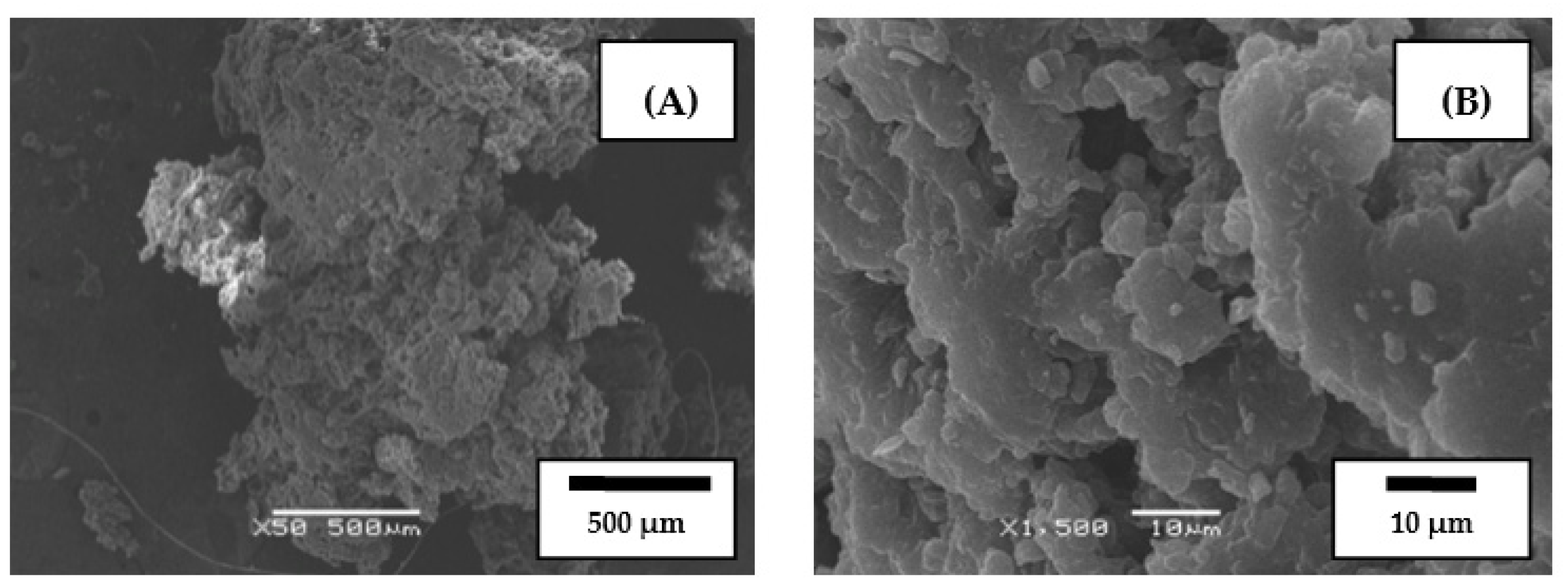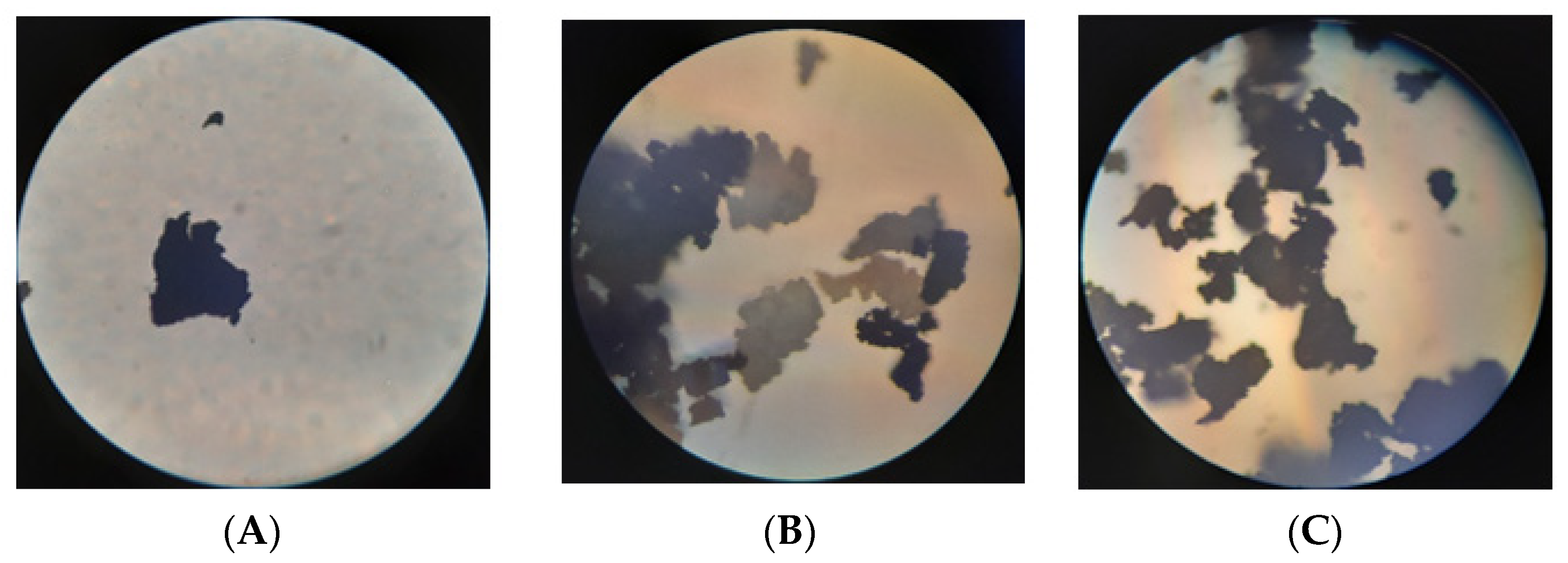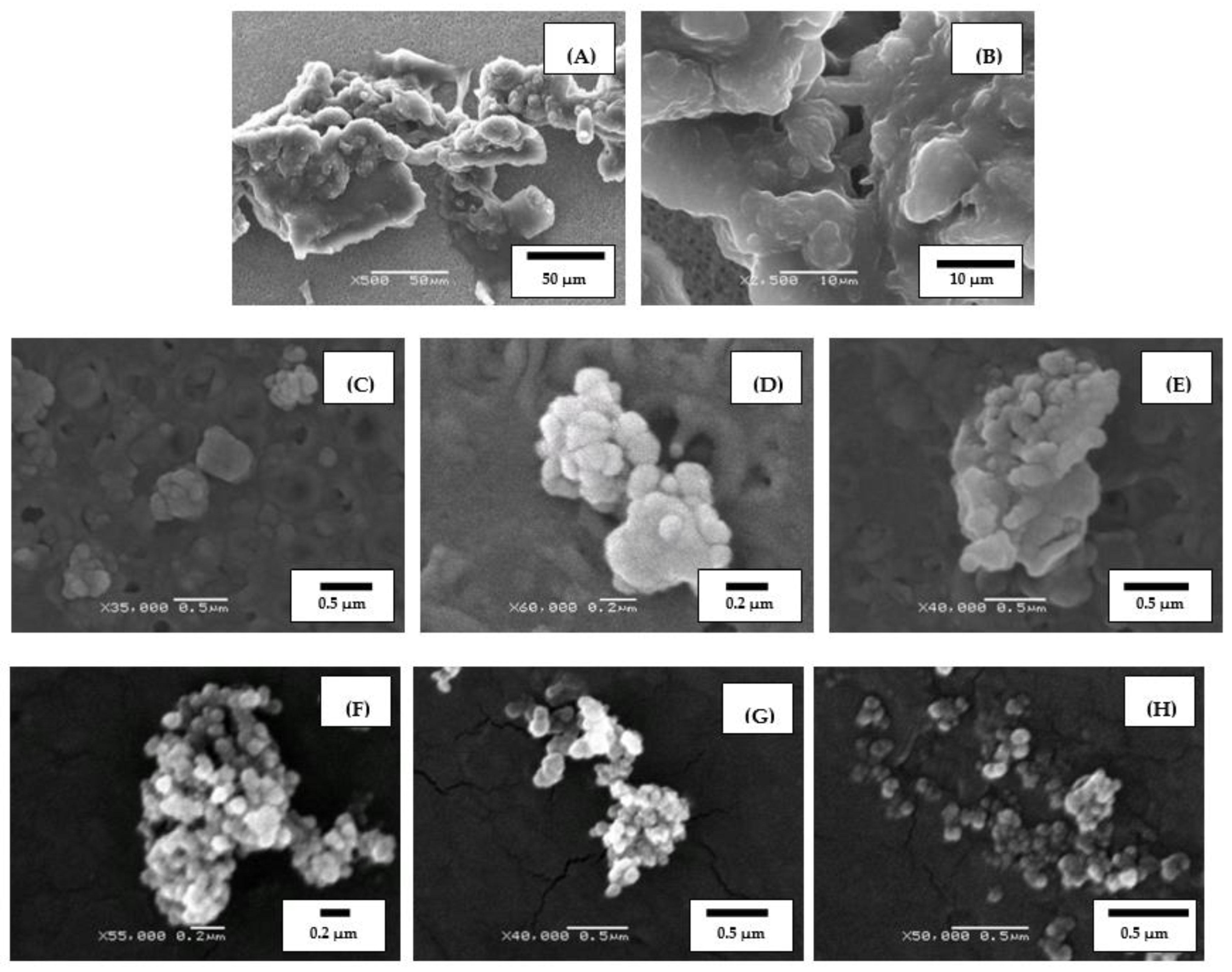Ultra-Dispersed Powders Produced by High-Temperature Shear-Induced Grinding of Worn-Out Tire and Products of Their Interaction with Hot Bitumen
Abstract
:1. Introduction
- -
- Rubber particles swelling in the maltene (aromatic) fraction of bitumen, i.e., the process of their volume expansion due to the absorption of light fractions from bitumen, meanwhile the penetration rate of the relevant bitumen fractions into the volume of the rubber particle is determined by the bitumen viscosity;
- -
- Devulcanization, i.e., breaking the C–S and S–S bonds in the vulcanized material;
- -
- Depolymerization, i.e., weakening of intermolecular bonds and breaking of C–C bonds in the rubber molecules.
2. Materials and Methods
2.1. Materials
- -
- Crumb rubber (CR) of unsorted worn tires with a size of less than 1 mm, obtained by grinding on rollers. The specific surface determined by the BET method at T = 77 K was about 0.3 m2/g.
- -
- Industrial linear butadiene styrene thermoplastic elastomer SBS L 30-01 (styrene content 30%, particle size about 1–2 mm (Sibur LLC, Moscow, Russia);
- -
- Powder elastomeric modifiers (PEM): APDDR and hybrid powder, obtained by high-temperature shear-induced grinding of CR in a rotary dispergator. APDDR was produced by grinding CR and hybrid powder by co-grinding of 80 wt.% CR and 20 wt.% SBS L 30-01. The APDDR and hybrid powder were homogeneous black powders less than 0.63 mm in size. The specific surface determined by the BET method at T = 77 K was at least 0.45 m2/g;
- -
- Modified binders prepared by mixing 10 ÷ 20 wt.% APDDR with 90 ÷ 80 wt.% bitumen heated to 120–180 °C with a paddle stirrer (IKA HB10 DIGITAL) for 1–40 min. Blown bitumen grade BND 60/90 with penetration of 60 dmm at 25 °C was used as a basis for the preparation of modified binders.
2.2. Research Methods
2.3. Preparation of Samples for Electron Scanning Microscopy
2.3.1. CR, APDDR, and Hybrid Powder Particles
2.3.2. Breakdown Products (Fragments of Original Particles) of APDDR in Hot Bitumen
3. Results and Discussion
3.1. Analysis of the Morphological Characteristics of CR and PEM
3.2. Study of Mechanisms of Interaction between PEM Particles and Bitumen
4. Conclusions
Author Contributions
Funding
Institutional Review Board Statement
Informed Consent Statement
Data Availability Statement
Conflicts of Interest
References
- Basel Convention Technical Guidelines on the Identification and Management of Used Tires. Basel Convention Series. SBC No. 02/10. 2002. Available online: http://archive.basel.int/meetings/sbc/workdoc/old%20docs/tech-usedtyres.pdf (accessed on 13 July 2022).
- Bressi, S.; Fiorentini, N.; Huang, J.; Losa, M. Crumb Rubber Modifier in Road Asphalt Pavements: State of the Art and Statistics. Coatings 2019, 9, 384. [Google Scholar] [CrossRef]
- Presti, D.L. Recycled Tyre Rubber Modified Bitumens for road asphalt mixtures: A literature review. Constr. Build. Mater. 2013, 49, 863–881. [Google Scholar] [CrossRef]
- Hassan, N.A.; Airey, G.D.; Jaya, R.P.; Mashros, N.; Aziz, M.A. A review of crumb rubber modification in dry mixed rubberized asphalt mixtures. J. Technol. 2014, 70, 127–134. [Google Scholar]
- Berlin, A.A.; Dudareva, T.V.; Krasotkina, I.A.; Nikol’skii, V.G. Tire-rubber-waste recycling and active powder of discretely devulcanized rubber. Polym. Sci. Ser. D 2018, 11, 323–329. [Google Scholar] [CrossRef]
- Porto, M.; Caputo, P.; Loise, V.; Eskandarsefat, S.; Teltayev, B.; Rossi, C. Bitumen and Bitumen Modification: A Review on Latest Advances. Appl. Sci. 2019, 9, 742. [Google Scholar] [CrossRef]
- Senise, S.; Carrera, V.; Navarro, F.J.; Partal, P. Thermomechanical and microstructural evaluation of hybrid rubberised bitumen containing a thermoplastic polymer. Constr. Build. Mater. 2017, 157, 873. [Google Scholar] [CrossRef]
- Sienkiewicz, M.; Borzędowska-Labuda, K.; Zalewski, S.; Janik, H. The effect of tire rubber grinding method on the rubber-asphalt binder properties. Constr. Build. Mater. 2017, 154, 144–154. [Google Scholar] [CrossRef]
- Loderer, C.; Partl, M.N.; Poulikakos, L.D. Effect of crumb rubber production technology on performance of modified bitumen. Constr. Build. Mater. 2018, 191, 1159–1171. [Google Scholar] [CrossRef]
- Hadadi, V. Effect of Concentration and Size of Crumb Rubber on Rheological and Cold Bending Properties of Bitumen. Iran. J. Polym. Sci. Technol. 2020, 32, 475–483. [Google Scholar] [CrossRef]
- Nguyen, H.T.; Tran, T.N. Effects of crumb rubber content and curing time on the properties of asphalt concrete and stone mastic asphalt using dry process. Int. J. Pavement Res. Technol. 2018, 11, 236–244. [Google Scholar] [CrossRef]
- Cong, P.; Xun, P.; Xing, M.; Chen, S. Investigation of asphalt binder containing various crumb rubbers and asphalts. Constr. Build. Mater. 2013, 40, 632–641. [Google Scholar] [CrossRef]
- Chen, Z.; Wang, T.; Pei, J.; Amirkhanian, S.; Xiao, F.; Ye, Q.; Fan, Z. Low Temperature and Fatigue Characteristics of Treated Crumb Rubber Modified Asphalt after a Long Term Aging Procedure. J. Clean. Prod. 2019, 234, 1262–1274. [Google Scholar] [CrossRef]
- Sheng, Y.; Li, H.; Geng, J.; Tian, Y.; Li, Z.; Xiong, R. Production and performance of desulfurized rubber asphalt binder. Int. J. Pavement Res. Technol. 2017, 10, 262–273. [Google Scholar] [CrossRef]
- Berlin, A.A.; Nikolskiy, V.G.; Krasotkina, I.A.; Dudareva, T.V.; Gorbarova, V.N.; Gordeeva, I.V.; Sorokin, A.V.; Lobachev, V.A.; Dubina, S.I.; Sinkevich, M.Y. Rubber and rubber-polymer modifiers of asphalt concrete mixtures produced by method of hightemperature shear grinding. Part 3. Evaluation of modification efficiency. Polym. Sci. Ser. D 2022, 15, 71–78. [Google Scholar] [CrossRef]
- Wang, H.; Apostolidis, P.; Zhu, J.; Liua, X.; Skarpas, A.; Erkens, S. The role of thermodynamics and kinetics in rubber–bitumen systems: A theoretical overview. Int. J. Pavement Eng. 2020, 22, 1785–1800. [Google Scholar] [CrossRef]
- Dick, J.S. Rubber Technology. Compounding and Testing for Performance; Hanser Publishers: Munich, Germany, 2001. [Google Scholar]
- Jamal, M.; Giustozzi, F. Low-content crumb rubber modified bitumen for improving Australian local roads condition. J. Clean. Prod. 2020, 271, 122484. [Google Scholar] [CrossRef]
- Han, L.; Zheng, M.; Wang, C. Current status and development of terminal blend tyre rubber modified asphalt. Constr. Build. Mater. 2016, 128, 399–409. [Google Scholar] [CrossRef]
- Gureev, A.A.; Tyukilina, P.M.; Simchuk, E.N.; Yen, N.T.T.; Overin, D.I. Development of Restoring Rubber Additives for Aged Road Bitumen. Chem. Technol. Fuels Oils 2019, 55, 395–403. [Google Scholar] [CrossRef]
- Li, H.; Dong, B.; Zhao, D.; Guo, P.; Zhang, J. Physical, Rheological and Stability Properties of Desulfurized Rubber Asphalt and Crumb Rubber Asphalt. Arab. J. Sci. Eng. 2019, 44, 5043–5056. [Google Scholar] [CrossRef]
- Hu, D.; Pei, J.; Li, R.; Zhang, J.; Jia, Y.; Fan, Z. Using thermodynamic parameters to study self-healing and interface properties of crumb rubber modified asphalt based on molecular dynamics simulation. Front. Struct. Civ. Eng. 2020, 14, 109–122. [Google Scholar] [CrossRef]
- Zhang, F.; Hu, C. The research for structural characteristics and modification mechanism of crumb rubber compound modified asphalts. Constr. Build. Mater. 2015, 76, 330–342. [Google Scholar] [CrossRef]
- Gaweł, I.; Piłat, J.; Radziszewski, P.; Kowalski, K.J.; Król, J.B. Rubber modified bitumen. In Polymer Modified Bitumen; Woodhead Publishing Limited: Sawston, UK, 2011; pp. 72–97. [Google Scholar] [CrossRef]
- Putman, B.J.; Amirkhanian, S.N. Crumb rubber modification of binders: Interaction and particle effects. In Proceedings of the Asphalt Rubber 2006 Conference, Palm Springs, CA, USA, 25–27 October 2006. [Google Scholar]
- Xu, O.; Rangaraju, P.R.; Wang, S.; Xiao, F. Comparison of rheological properties and hot storage characteristics of asphalt binders modified with devulcanized ground tire rubber and other modifiers. Constr. Build. Mater. 2017, 154, 841–848. [Google Scholar] [CrossRef]
- Kutay, E.; Ozturk, H. An analysis using 3D microtomography imaging. In Proceedings of the Asphalt Rubber 2012 Conference, Munich, Germany, 23–26 October 2012; pp. 503–512. [Google Scholar]
- Daly, W.H.; Balamurugan, S.S.; Negulescu, I.; Akentuna, M.; Mohammad, L.; Cooper, S.B., III; Cooper, S.B., Jr.; Baumgardner, G.L. Characterization of Crumb Rubber Modifiers after Dispersion in Asphalt Binders. Energy Fuels 2019, 33, 2665–2679. [Google Scholar] [CrossRef]
- Kompaniets, L.V.; Krasotkina, I.A.; Erina, N.A.; Zhorin, V.A.; Nikolsky, V.G.; Prut, E.V. Effect of intense plastic deformation on relaxation transitions of polyolefins and blends based on them. Polym. Sci. Ser. A 1996, 38, 792–798. [Google Scholar]
- Sokolov, A.K.; Garishin, O.K.; Svistkov, A.L. Structural modeling of damage development in disperse-filled elastomeric nanocomposites taking into account interfacial interactions. Comput. Contin. Mech. 2019, 12, 378–389. [Google Scholar] [CrossRef] [Green Version]







Publisher’s Note: MDPI stays neutral with regard to jurisdictional claims in published maps and institutional affiliations. |
© 2022 by the authors. Licensee MDPI, Basel, Switzerland. This article is an open access article distributed under the terms and conditions of the Creative Commons Attribution (CC BY) license (https://creativecommons.org/licenses/by/4.0/).
Share and Cite
Nikol’skii, V.; Dudareva, T.; Krasotkina, I.; Gordeeva, I.; Vetcher, A.A.; Botin, A. Ultra-Dispersed Powders Produced by High-Temperature Shear-Induced Grinding of Worn-Out Tire and Products of Their Interaction with Hot Bitumen. Polymers 2022, 14, 3627. https://doi.org/10.3390/polym14173627
Nikol’skii V, Dudareva T, Krasotkina I, Gordeeva I, Vetcher AA, Botin A. Ultra-Dispersed Powders Produced by High-Temperature Shear-Induced Grinding of Worn-Out Tire and Products of Their Interaction with Hot Bitumen. Polymers. 2022; 14(17):3627. https://doi.org/10.3390/polym14173627
Chicago/Turabian StyleNikol’skii, Vadim, Tatiana Dudareva, Irina Krasotkina, Irina Gordeeva, Alexandre A. Vetcher, and Alexander Botin. 2022. "Ultra-Dispersed Powders Produced by High-Temperature Shear-Induced Grinding of Worn-Out Tire and Products of Their Interaction with Hot Bitumen" Polymers 14, no. 17: 3627. https://doi.org/10.3390/polym14173627
APA StyleNikol’skii, V., Dudareva, T., Krasotkina, I., Gordeeva, I., Vetcher, A. A., & Botin, A. (2022). Ultra-Dispersed Powders Produced by High-Temperature Shear-Induced Grinding of Worn-Out Tire and Products of Their Interaction with Hot Bitumen. Polymers, 14(17), 3627. https://doi.org/10.3390/polym14173627






